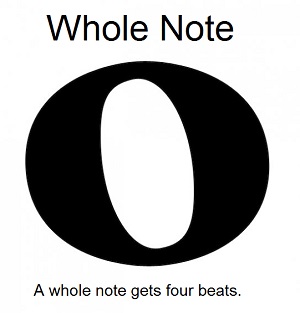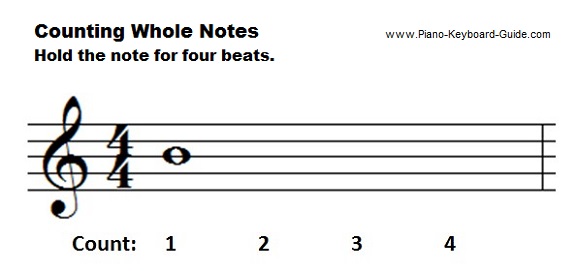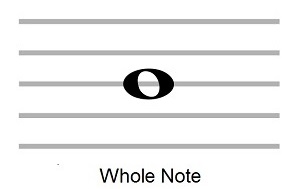A whole note, also called a semibreve (British) is the note with the longest time value in modern music. Its length is equal to four beats and takes up an entire bar in 4/4 time. It’s equivalent in value to four quarter notes.
Highly Recommended: Click here for one of the BEST piano/keyboard courses I’ve seen online.
It is represented by a hollow oval note head. Unlike half notes, it has no stem. As I always say to students, it looks like a hole. Most other notes are fractions of the semibreve. For instance a half not is played for half the duration of the whole, a quarter note for a quarter of the duration and an eighth note for a eighth of the duration.
COUNT: “1 – 2 – 3 – 4” while holding the note down on your piano or keyboard. You can also say “Whole-note-hold-down”.
You can count “one and two and three and four and”.
Here’s a large printable whole note symbol.
whole note symbol.
Do you have access to a metronome? It’s a great tool for understanding the proper way to play a whole note (semibreve). If you don’t have a physical one, you can search the Internet for an online metronome.
Start your metronome. Each click corresponds to a beat. Count, “1,2,3,4,1,2,3,4,1,2,3,4….” and so on. Hold down the note for four beats. Each time you restart on 1, a new measure starts and you should play the note again on that beat.
Play this: note, click , click, click, note, click, click, click, note, click, click, click and so on. Remember to hold down the note for four clicks. Keep practicing this until you clearly understand and have a feel for this type of note.
Here’s a great video about this note (Learn how to count):
 Think of a measure as a pie. It can be divided into halves (2 pieces), quarters (4 pieces) or eighths (8 pieces). A whole note is called that way because it is played and held for a whole measure. 1 whole note = 2 half notes = 4 quarter notes = 8 eighth notes = 16 sixteenth notes.
Think of a measure as a pie. It can be divided into halves (2 pieces), quarters (4 pieces) or eighths (8 pieces). A whole note is called that way because it is played and held for a whole measure. 1 whole note = 2 half notes = 4 quarter notes = 8 eighth notes = 16 sixteenth notes.
Here’s a large printable one on a line.
A related symbol is the whole rest (or semibreve rest), which usually denotes a silence for the same duration. When you come across a whole rest, you simply rest (play nothing) for the duration of four beats. Whole rests are drawn as filled-in rectangles hanging under the second line from the top of a musical staff.
Piano notes and keys – Learn the notes which correspond to the keys on the piano.